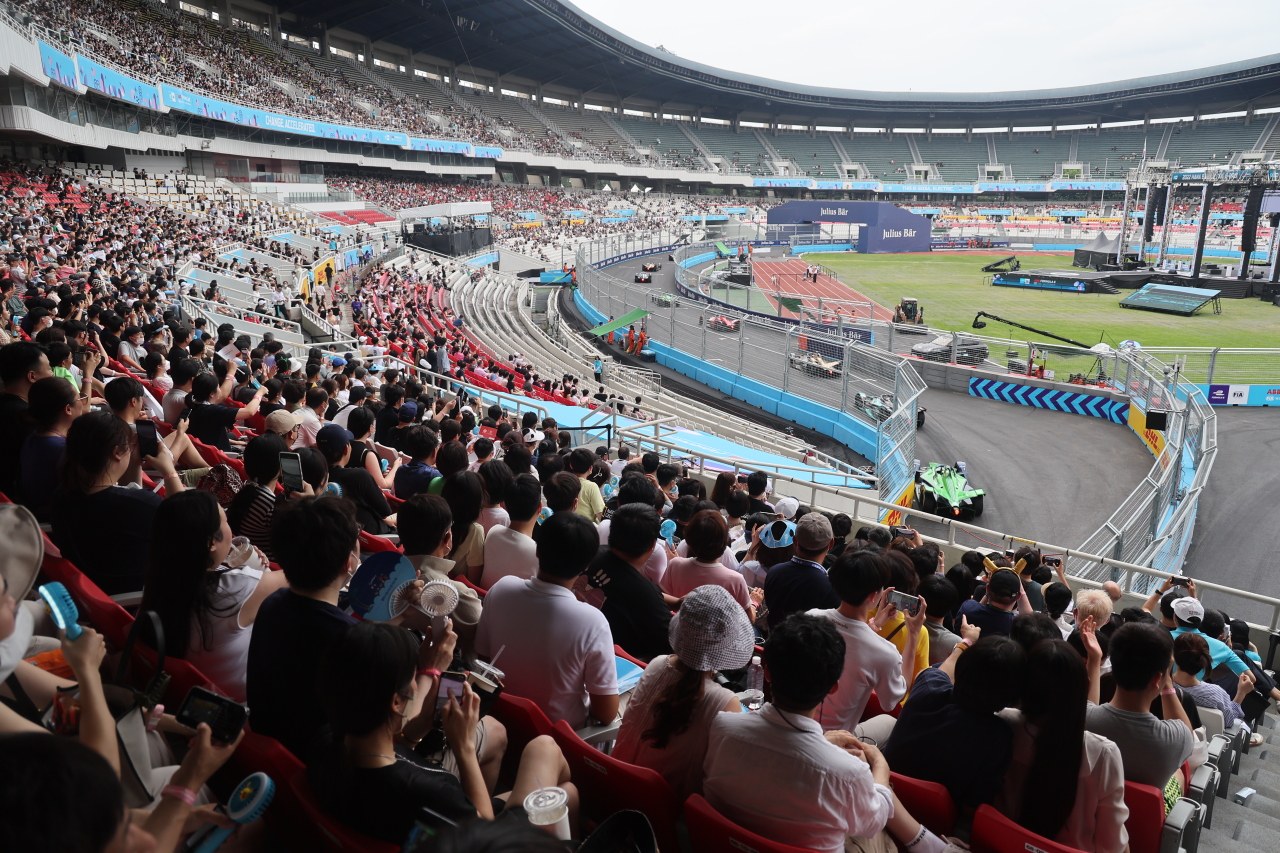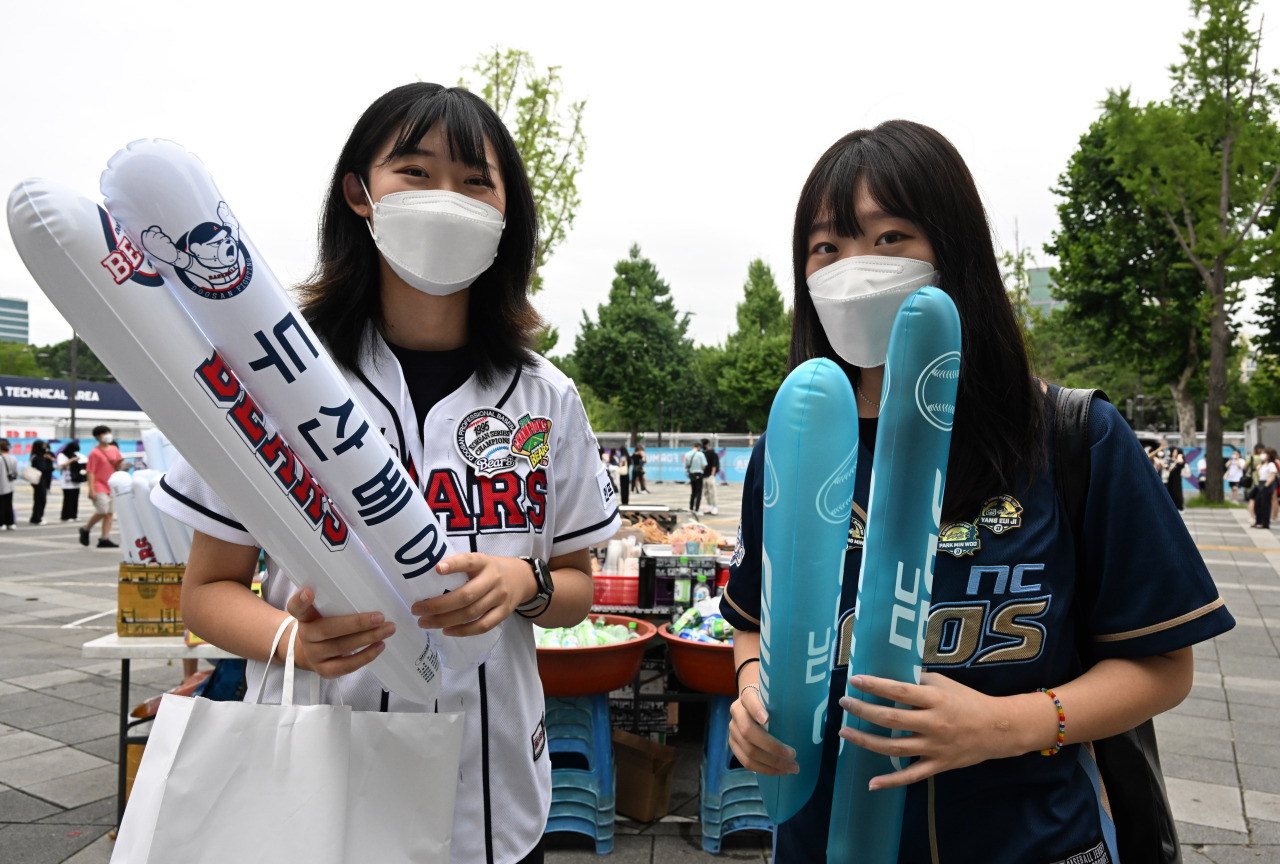 |
Spectators gather at Olympic Stadium of the Seoul Sports Complex in Songpa-gu, southern Seoul, on Aug. 14 to watch the 2022 Hana Bank Seoul E-Prix. (Yonhap) |
Hours before the baseball game between the Doosan Bears and Kiwoom Heroes in Seoul on Thursday, the area around Sports Complex Station was bustling with colorfully dressed fans, merchants and even scalpers calling out to bystanders.
The scene was in stark contrast to just a year before, when the Korea Baseball Organization sold only 50, 30, 10 or zero percent of the seats, depending on the COVID-19 pandemic situation at the time.
Korean pro sports are back, and the jam-packed exits at the station were there to show it.
Mecca of sports, large events in Seoul
South Korea’s largest integrated sports center, Seoul Sports Complex is more frequently referred to as Jamsil Sports Complex for its location in the eponymous neighborhood.
It was built in 1984 as the country prepared, with wide excitement and anticipation, to host the 1986 Asian Games and 1988 Summer Olympics. The capital playing host to the megasized sports event was hailed as proof of the country’s ascent from the ashes of the Korean War decades before and its rising global profile at that time.
Spanning an area of 402,816 square meters, the complex consists of the iconic Olympic Stadium, Jamsil Baseball Stadium, several adjacent buildings and a public park.
Serving as a gateway to all these venues is Sports Complex Station on Line Nos. 2 and 9 of the Seoul Metro.
Upon getting off the platform, one could immediately tell this is the land of sports: etched across the platforms and waiting rooms of Line No. 2 are pictograms of sporting events. Eight exits are allocated for Line No. 2, while the much-later built Line No. 9 has only one exit leading to the nearby park.
 |
Baseball fans exit Sports Complex Station in Songpa-gu, southern Seoul, on Aug. 10, moments before a game between the Doosan Bears and NC Dinos. (Im Se-jun/The Korea Herald) |
The exits leading directly to Seoul Sports Complex are Nos. 5, 6, 7 and 8, with No. 5 leading straight to the baseball stadium -- the shared home of the Doosan Bears and LG Twins -- and No. 8 leading to the Student Gymnasium of Seoul Metropolitan Office of Education, which is occupied by the SK Knights of the Korea Basketball League. Nos. 6 and 7 lead to the main gate, where one can walk straight to Seoul Jamsil Gymnasium, home of the KBL’s Samsung Thunders, and the behemoth Olympic Stadium itself.
Olympic Stadium, as the name indicates, was used as the main venue for the 1988 Summer Olympics in Seoul. It has the largest capacity of any sports arena in the country at just shy of 70,000, or maxing out at 100,000 including standing room.
Its relatively antiquated facilities, however, make it unsuitable for many premier or global events currently.
While the nearly 40-year-old building may be too old to host pro games, its giant bleachers have made it the perfect spot for concerts or other events of a correspondingly huge scale. This is where Ultra Korea, the local edition of the international electronic dance music-based Ultra Music Festival, is held annually -- this year on Sept. 24-25.
 |
Baseball fans wearing the jerseys of the Doosan Bears (left) and NC Dinos pose for a photo before a game held at Seoul Sports Complex in Songpa-gu, southern Seoul, on Aug. 10. (Im Se-jun/The Korea Herald) |
As for concerts by a single music act, Jamsil Gymnasium is the more coveted venue.
Selling out the gymnasium has been a feat accomplished by only the most popular artists of the time.
The first-ever artist to hold a concert there was the great Stevie Wonder in 1995, a feat that was repeated the following year by the “king of pop,” Michael Jackson, who set a record for an artist visiting South Korea by selling about 76,000 tickets for two nights.
Since then, a number of international musicians like Roger Waters, Elton John, Metallica, Lady Gaga and Paul McCartney have followed suit, with Coldplay breaking Jackson’s record by selling 100,000 tickets for two shows.
H.O.T., popular K-pop boy band from the 1990s, was the first Korean act ever to hold a concert there, and contemporary K-pop stars like EXO, BTS and IU have also occupied the giant stage. Psy held his annual “Summer Swag” concert here earlier in the year, a show famous for showering fans with gallons of water.
Seoul Festa 2022 was also held Aug. 10-14 at the main stadium, marked by K-pop performances and the Seoul E-Prix, for the country’s first time hosting the Formula E electric motorsports championship.
 |
Olympic Stadium (Yonhap) |
Of course as in most cases, fame accompanies unwelcomed complications.
On Aug. 7, an anonymous online post claiming to be from a “warrior of the Islamic State” warned there would be three bomb attacks at the complex later that day. This caused evacuations of some 1,000 workers preparing for the Seoul Festa, as well as the players, coaching staff and employees of the LG Twins preparing for a game later that day.
After an hourslong search by authorities, the temporary shutdown of Sports Complex Station and canceling the Twins’ fan event, the whole thing was revealed to be a “prank” by a mentally challenged man in his 20s.
Despite the hiccup caused by the prank or the occasional cancellation of a game such as due to the recent heavy downpours, Seoul Sports Complex is as much of a beloved venue for concerts and events as it is a mecca of Seoul sports.
Next month, DJ Alan Walker is slated to hold a concert at Seoul Jamsil Gymnasium on Sept. 14 as part of his ongoing world tour.
By Yoon Min-sik
(
minsikyoon@heraldcorp.com)











![[Today’s K-pop] Blackpink’s Jennie, Lisa invited to Coachella as solo acts](http://res.heraldm.com/phpwas/restmb_idxmake.php?idx=644&simg=/content/image/2024/11/21/20241121050099_0.jpg)